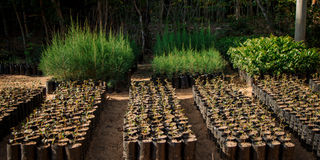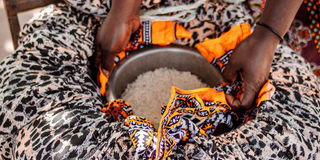Premium
Communities restoring the ecosystem

Members of the Wildlife Club at Mjombani Primary School in Gede, Kilifi County. Teachers and pupils have taken to environmental restoration by tree planting within and outside of the school.
Watamu is known globally as a hotspot for conservation. It is here that A Rocha Kenya, a Christian organisation that deals with environmental care, community conservation and marine research has established itself. Using the church as a gateway to the community, A Rocha Kenya provides a classical way of working with communities to do conservation work.
A Rocha Kenya is one of the 20 projects around the world under the umbrella A- Rocha International working in conservation, according to Dr Colin Jackson, the director at A Rocha Kenya.
“The work of the Kenya Community Development Foundation (KCDF) and I&M Bank Foundation partnership fits into our assets programme which has since 2001 helped communities to build sustainable ways of living,” he added.
For instance the use of solar lighting systems and energy saving jikos have reduced overreliance on firewood. This has seen a clean environment where communities are actively engaged in tree planting to expand the Arabuko-Sokoke Forest which stretches from Somalia, through Kenya, up to Mozambique.
The programme has impacted over 4,500 community members in its first year. “In the second year, we would like to work with a long-term vision so that local communities can benefit in a sustainable way through the ‘Cut Woods Project’ where the community grows trees and curbs charcoal burning in unprotected forests.”

Alex Thoya displays the seedling of the Mvule tree, which is one of the most endangered indigenous tree species in Arabuko-Sokoke Forest.
The Arabuko-Sokoke Forest has a rich biodiversity of wildlife and birds. Rocha Kenya has been involved in the establishment of seedbeds for indigenous trees to supply seedlings to schools and the community towards forest restoration. Since June 2021, A Rocha Kenya has planted over 3714 indigenous trees through schools.
“We work with parents in the assets bursary scheme so that they can plant more trees in the forest, conserve the existing trees and not cut them down for charcoal. In return, their children’s school fee is paid,” said Stanley Baya, the community conservation manager at A Rocha Kenya.
At Mnazi Mmoja village in Mijomboni, Gladys Zame Msuko is a beneficiary of the A Rocha Kenya assets programme where her son is a beneficiary of a secondary school bursary. As happens with all other beneficiaries in the programme, Ms. Msuko is involved in tree planting in her community and is one of the champions of the fireless cookers. This is an innovative restoration model that ensures that the community does not have to destroy the forest trees for economic gains such as charcoal trade. This has seen the community fully own the project in a sustainable manner.
Through the programme, parents are given seedlings to plant in the forest, public places and at their homes and they are trained on how to nurture them. Most of the indigenous trees are endangered species, having been cut for charcoal burning, says Alex Thoya who mans the A Rocha Kenya seedbed located next to Arabuko-Sokoke Forest.
According to Thoya, the need to restore the indigenous trees such as blue gum, Mkulu, Msandarusi, Mwamba and Mvule emanate from the fact that they normally take a longer time to grow and have a high economic value as most are hard woods that are used for construction, furniture and in carving. Due to changes in rain patterns, some indigenous trees have changed and due to lack of water their survival rate is low. For instance, flooding affects the ecosystem of mangroves. The project also grows exotic tree seedlings because they assist the community in building and to earn an income.
Patrick Kilumo, the project officer at A Rocha Kenya, says the organisation has been working with KCDF and I&M Bank Foundation as partners to educate the community on the use of fireless cookers, solar lamps and tree planting. “This has promoted our work and relationship with the community. If not for KCDF and I&M Bank Foundation, our green energy conservation work would have been limited.”
The use of fireless cookers reduces cutting of trees for firewood and gives more benefits. While in villages, people use hotpots to keep their food warm for longer, fireless cookers achieve the same and are less costly, he added.

An indigenous trees nursery bed located next to Arabuko-Sokoke Forest. A Rocha Kenya distributes the seedlings to the neighbouring community and schools for tree planting activities through the Cut Wood Projects.
Their usage gives economic and social value. “They help to minimise domestic fights as husbands can enjoy having hot food late at night, yielding happier families.”
The freedom that has come with fireless cookers
Ms Msuko grows maize and keeps cows, goats, and sheep and one of her children is being assisted to access secondary school education by A Rocha Kenya through an education scholarship. She has also been trained to make and use fireless cookers. “I use it mainly to cook rice, cassava and to keep my food warm. It cooks so well,” Ms Msuko shared.
“At first I couldn’t comprehend how a cloth-made fireless cooker works, until I saw it cook,” said Ms Msuko.
A fireless cooker is a basket made of cloth material and has chambers that are filled with sponge, fibre, pieces of cloth, saw dust, dry leaves or dry grass for insulation. It also has a cloth cover that is fully insulated.
When using a fireless cooker the food has to be precooked on fire for a few minutes before it is transferred into the fireless cooking basket. You then close the cover and fasten the string so that no steam or energy escapes, Ms Msuko explained as she cooked rice in a demonstration.
The food, rice, pasta or cassava stays there for not more than a-half-an-hour and cooks well.
Using a fireless cooker gives many benefits. “It saves on energy, and time as we rarely go to collect firewood. Firewood use has also reduced. I am able to use the same amount of firewood that I used for a week, for two and a half weeks,” Ms Msuko said.
But it is the freedom that has come with the use of the fireless cooker that has liberated her womenfolk the most. “It frees us a lot of time to rest and do other things, unlike before when cooking was such a tiring venture. Cooking has been made easier, I am no longer sweating it out in the kitchen,” she said as a matter-of-fact.

Gladys Zame Msuko uses the fireless cooker to cook rice at her homestead in Mnazi Mmoja village in Mijomboni, Kilifi County. Fireless cookers have reduced felling of trees in the area
The fireless cooker is smokeless and safe to use indoors. “The smoke from firewood used to affect my breathing. My children would start coughing and I was always in the rush to buy cough syrups,” She shared. Her household has now been freed from coughs and allergies that come with smoke. “I am telling you, this fireless cooker is total freedom,” Ms Msuko said.
Besides, with the fireless cooker, her children are assured of a hot lunch when they get back from school. This is unlike before when Ms Msuko would prepare their lunch meal in the morning, and they take it cold during their lunch break.
The fireless cooker is able to keep warm for longer, even her husband is assured of a warm meal late at night, thanks to the fireless cooker. “He had initially asked if I would be cooking for him from a ‘cloth cooker’. Of late, he is very receptive.”
She is among 23 community members who have been trained on how to make the fireless cookers and they are making use of them for their cooking needs. An additional 15 fireless cookers are being made and will be in use by the end of November.
If well adopted, the fireless cookers will no doubt save forest trees in Gede. The A Rocha community conservation project has been supported thanks to a three-year partnership between KCDF and I&M Bank Foundation that seeks to strengthen community participation in environmental conservation in Kilifi County.
Through the partnership, A Rocha Kenya is raising community awareness on the implication of the community’s livelihood activities on the environment and their impact on the changing climate.
The focus is on training and equipping community members on using sustainable, safe and efficient energy saving cookers to alleviate the pressure exerted on Arabuko-Sokoke Forest for fuelwood and charcoal. Under the partnership with KCDF, I&M has set aside an investment of over KSh50 million from the Bank’s Foundation in the next three years which is expected to benefit over 5,000 households.
Among many of the rural communities where KCDF works, a majority rely on agriculture and natural resources to survive. For these people, the effects of climate change - limited water, energy, food sources and increased competition for them - are a critical matter.
As a result, considering the challenges each community is facing, and then developing localised solutions that will make the biggest impact remains a big challenge.
KCDF together with its partners is broadening its approach in this area by strengthening the capacity of communities to have a voice in conservation initiatives affecting them and also assisting such communities to adjust to the vagaries of climate variability.





